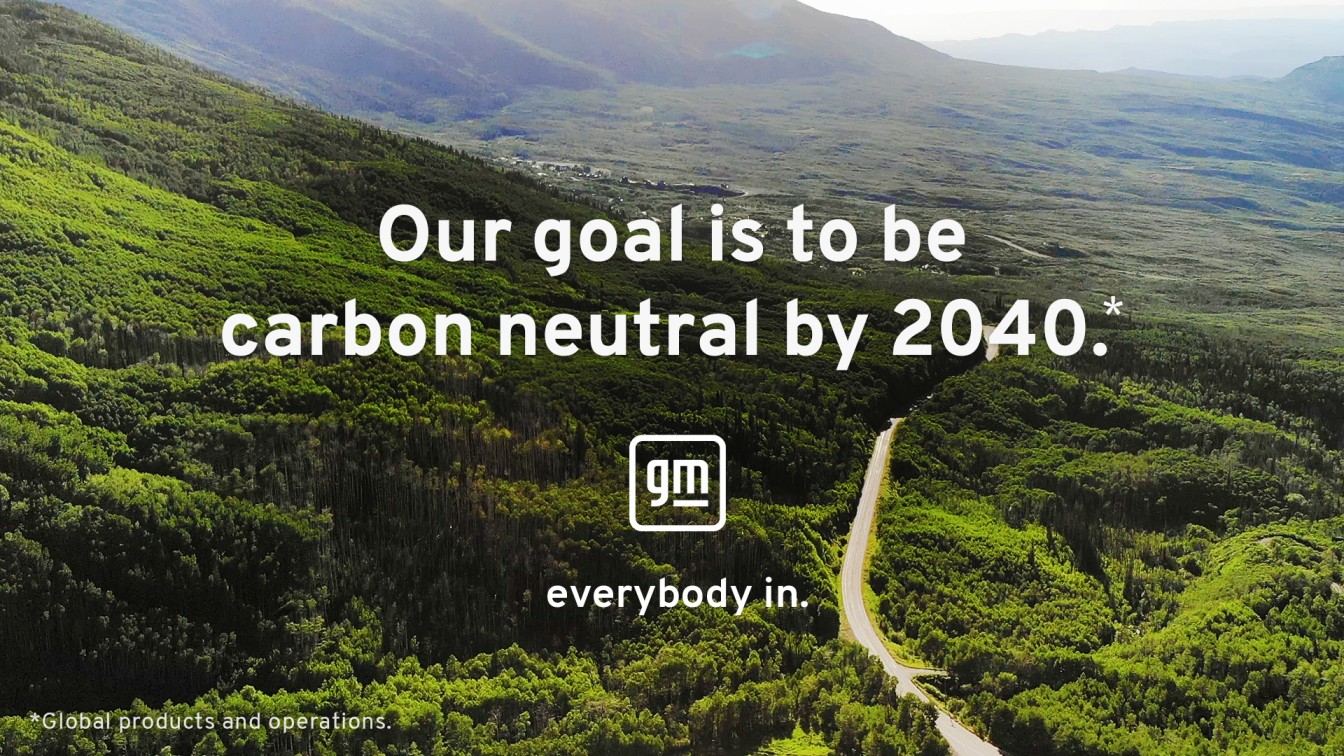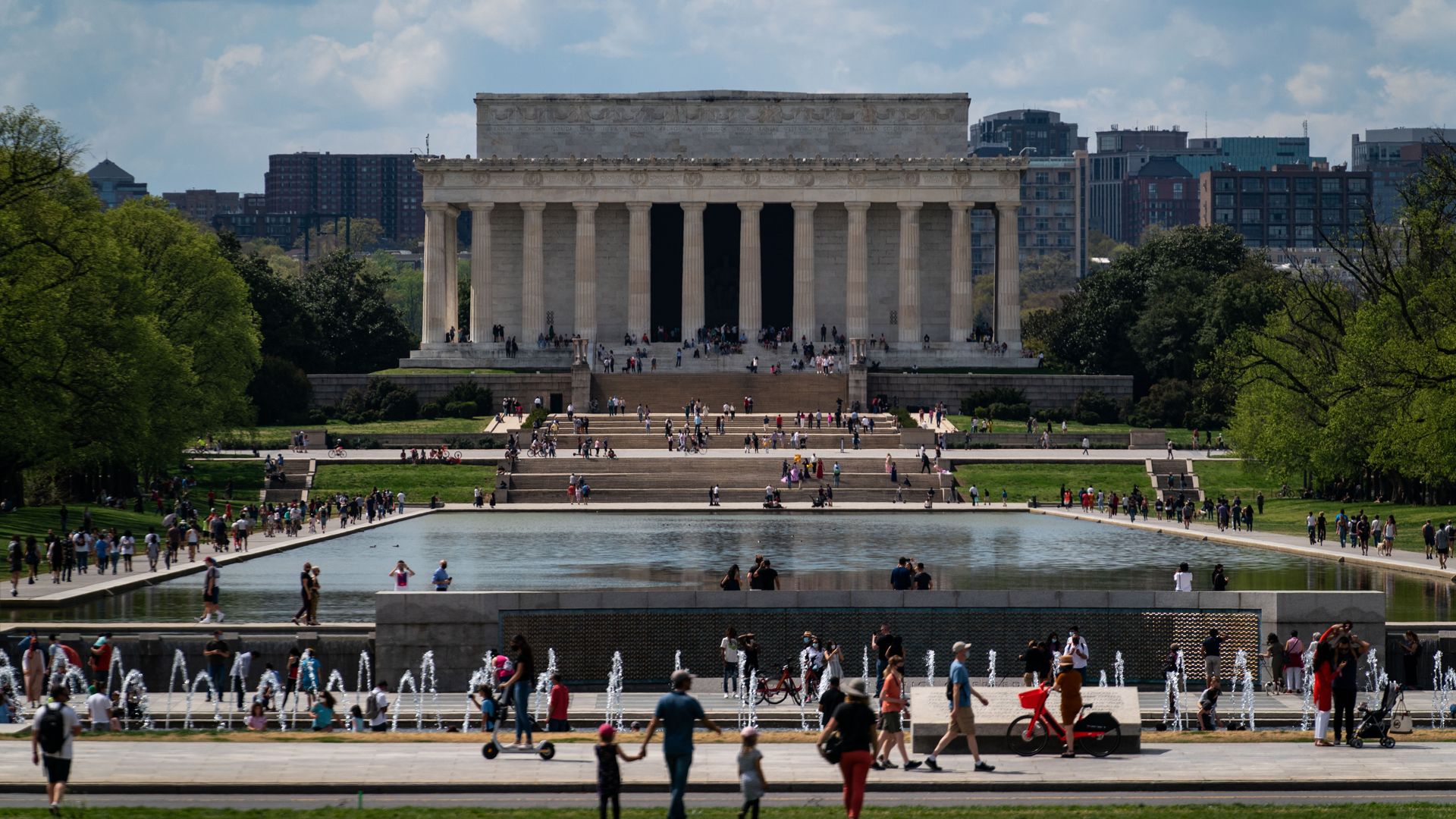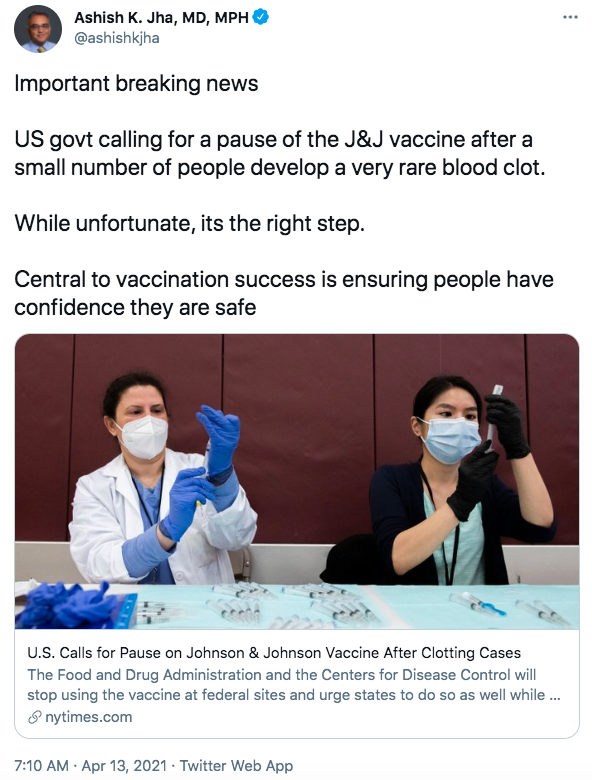| | | | | | | Presented By General Motors | | | | Axios Future | | By Bryan Walsh ·Apr 14, 2021 | | Welcome to Axios Future, currently coming from New York, America's eighth favorite state by popularity, but No. 1 when it comes to governors under a cloud of political scandal. Today's Smart Brevity count: 1,663 words or 6½ minutes. | | | | | | 1 big thing: Why our brains struggle to analyze risk |  | | | Illustration: Aïda Amer/Axios | | | | The decision to pause the use of Johnson & Johnson's COVID-19 vaccine — and the furor that now surrounds it — underscores the confounding psychology behind risk assessment. Why it matters: From vaccines to emerging technologies, the future will force us to make difficult, risk-based choices that our Stone Age brains are ill-equipped to handle, especially in an environment where social trust has evaporated. Driving the news: The FDA's move on Tuesday to halt J&J vaccinations came after reports that six women out of roughly 7 million people who had received that shot experienced potentially dangerous blood clots, with one dying. - On Wednesday, the CDC's vaccine advisers agreed to a pause of at least a week and a half as they review safety data.
- Based on those numbers alone, the decision may look puzzling.
- As my Axios colleague Sam Baker reports, common medications like birth control as well as the coronavirus itself carry a much higher risk of blood clots than the extremely rare side effects seen so far with J&J's shot, while any delay in vaccine rollout raises the risk of continuing the deadly pandemic.
Yes, but: We don't evaluate vaccines based on a simplified cost-benefit analysis — not that our brains are great at making those calculations anyway. - Virtually unique among medical interventions, vaccines are given to healthy people to prevent disease, which demands a higher level of safety.
- Because a vaccine for a disease like COVID-19 ultimately needs to be taken by the bulk of the population to effectively stop the pandemic, keeping public trust in their safety and quality is paramount — which is precisely what the FDA's pause is meant to inspire.
The catch: Since we naturally tend to evaluate risk on an emotional rather than a mathematical level, there's no guarantee the move will accomplish its aim. - Psychological research has shown that under conditions of uncertainty — which definitely includes the pandemic — most people make judgments not off hard numbers, but using mental shortcuts that can be heavily influenced by emotion.
- Seeing the government stop distribution to investigate apparently very low levels of risk theoretically should help shore up vaccine confidence in the U.S., where 30% of people surveyed in a recent poll said they definitely aren't going to take or will wait and see about getting a COVID-19 vaccine.
- But in Europe — with the exception of the U.K. — public confidence in the AstraZeneca vaccine plunged after countries temporarily halted its distribution, even though the EU medical regulator said it was safe and effective.
Of note: A pause wouldn't have much effect on Americans' vaccine confidence if they had full trust in their leaders — but a survey earlier this year indicated that trust in every institution has fallen to historic lows. The big picture: The future will present even more complex questions about risk analysis that we may be ill-equipped to process. The bottom line: The FDA paused J&J out of an "abundance of caution" — and it was likely correct to do so. - But in a pandemic — and in a risky future more generally — it won't always be easy to identify which decision is ultimately more cautious.
|     | | | | | | 2. The push to define workers' rights in space |  | | | Illustration: Aïda Amer/Axios | | | | As humanity stretches into orbit and beyond, experts are still grappling with how rights afforded to workers on Earth might apply to those living in space, I write with my Axios colleague Miriam Kramer. Why it matters: In order to create businesses and societies in space — where the biological necessities for sustaining human life, like air and water, aren't readily available — there will need to be fundamental rights agreements to guarantee laborers aren't exploited. Between the lines: Translating human rights to professional astronauts and other spaceflyers isn't necessarily straightforward. Experts say the international community needs to start grappling with that now, decades before we have a city on Mars. - For example, how would the right to free expression work for a mistreated worker aboard a private space station where a company supplies air and life support?
What's happening: The UN's Outer Space Treaty classifies astronauts as a protected group who should be considered emissaries of humanity with rights and protections. - But rules around the rights of private astronauts in space aren't clearly defined in the treaty, and that could complicate things as more companies work to send private citizens to space.
The intrigue: While defining what rights a laborer has off-Earth may seem premature today, experts say that decisions made now will influence what rights look like in orbit for decades to come. - "It's not hard to imagine a 'company town' scenario where employers can wield incredible leverage over workers by controlling almost every aspect of their existence," Ed Finn, founding director at the Center for Science and the Imagination at Arizona State University, tells Axios.
Read the whole story. |     | | | | | | 3. Companies struggle to manage on-demand workforces |  | | | Illustration: Rebecca Zisser/Axios | | | | A new report explores the challenges of managing "workforce ecosystems" increasingly made up of non-permanent employees. The big picture: The emergence of new labor-sharing platforms, the push to cut costs, and workers' own preferences all drive the emergence of a distributed workforce — and companies need to adjust their management strategies. By the numbers: In a survey by Deloitte and MIT Sloan Management Review of more than 5,000 corporate professionals and leaders from around the world, 87% of managers reported that they consider non-permanent workers — like contractors, gig workers and even bots — to be part of their workforce. - A third of respondents say they expect to rely more on non-permanent workers over the next 18–24 months, and more than half say they'll use online platforms to access external talent.
- "We're seeing the total workforce that an organization engages to do work on their behalf as part a 'workforce ecosystem,'" says Robin Jones, U.S. workforce transformation leader at Deloitte.
Of note: While it's easy to think of gig workers as the corporate equivalent of second-class citizens, "there's a greater focus on really high-cost, high-skill occupations like data scientists" among the extended workforce, says Balaji Bondili, head of Deloitte Pixel. The catch: Only 28% of those surveyed say they are sufficiently prepared to manage that new ecosystem. What to watch: How companies shift their talent management structure to compensate for a much more varied workforce ecosystem. - "If organizations can literally rewire themselves to create a more personalized experience while continuing the trajectory of work productivity and output, that is going to be the holy grail," Jones says.
|     | | | | | | A message from General Motors | | General Motors' mission is zero-emissions | | |  | | | | By 2040, it is our goal to be carbon neutral and source 100% renewable energy to power our U.S. sites. What GM is doing: Which is why we are investing in sustainable processes, flexible platforms and EVs that are accessible to all. Learn more about the initiative. | | | | | | 4. Drug overdoses hit record during pandemic |  Data: CDC; Chart: Danielle Alberti/Axios New data shows that more Americans died of drug overdoses in the year leading to September 2020 than any 12-month period since the opioid epidemic began. Why it matters: The stubborn increase of such "deaths of despair" shows that the opioid epidemic still has room to grow and that some of the social distancing steps we took to rein in the pandemic may have brought deadly side effects. By the numbers: More than 87,000 Americans died from drug overdoses in the 12 months leading to September 2020, according to preliminary federal data released this week. - That represents a 29% increase in overdose deaths for the months between October 2019 and September 2020 compared to the prior year.
- While overdose deaths from drugs had begun rising in the months leading to the pandemic — after dipping slightly in 2018 for the first time in years — the biggest spike in deaths occurred in April and May 2020, when shutdowns were strictest.
Of note: While the earliest years of the opioid epidemic were worst among white Americans in rural and suburban areas, Black Americans are now suffering disproportionately. Details: Experts connect some of the increase in overdose deaths to the social isolation and temporary closure of many treatment programs during the pandemic. - One study found that people used drugs more frequently during the pandemic, and often did so alone, putting them at greater risk of dying of an overdose.
- At least 25% of syringe-service programs reported having to close sites because of distancing policies during the pandemic, and nearly half had to restrict operating hours.
Go deeper: The New York Times published a stark piece today about the havoc caused by the opioid epidemic in the suburban Pennsylvania town of Hatboro, just a few miles from where I grew up. The bottom line: As we worry about the very rare side effects of some COVID-19 vaccines, we shouldn't forget about the deadly unintended consequences of other measures designed to control the pandemic. |     | | | | | | 5. Worthy of your time | | Surely we can do better than Elon Musk (Nathan J. Robinson — Current Affairs) - An amusing takedown of our love affair with the often over-promising, sometimes under-delivering, real-life Tony Stark.
The best remedy for our diseases? Aging less (Andrew Steele — Wall Street Journal) - Aging is the true "captain of the men of death," and attacking the biological mechanisms behind getting older could be our best strategy for fighting disease.
Quantum computing's reproducibility crisis: Majorana fermions (Sergey Frolov — Nature) - Quantum computing is set to change the world — just as soon as experts in the field figure out whether a foundational aspect of the technology actually exists.
How to survive a killer asteroid (Cody Cassidy — Wired) - Step one: Happen to be in a very, very, very deep cave.
|     | | | | | | 6. 1 fun thing: American states, ranked by Americans |  | | | Greetings from lovely Washington, D.C., the worst state or federal district in America, as chosen by Americans. Photo: Kent Nishimura/Los Angeles Times via Getty Images | | | | A new survey of Americans reveals their favorite — and least favorite — U.S. states. The big winner: Hawaii, no surprise. I mean, seriously, look at this place. The big losers: The 705,749 residents of Washington, D.C., which was included on the list despite not being a state ... and finished dead last. How it works: YouGov asked respondents to pick the better of two states in a series of head-to-head matches, then ranked them based on their winning percentage. - Colorado came in second, winning 65% of its matchups — a result YouGov attributed to its "scenic mountains, hiking paths, and recreational marijuana industry."
My thought bubble: One could argue that "scenic mountains" and "hiking paths" are essentially the same thing, but these kinds of fine distinctions may be lost after you've sampled the Centennial State's recreational marijuana industry. Details: After Washington, D.C., the bottom rankings were dominated by Southern and Midwestern states like Alabama and Kansas, though New Jersey made a strong showing at #48, presumably for being New Jersey. The bottom line: Respondents living in the state of their birth chose them 81% of the time in head-to-head matchups, reinforcing the idea that for most Americans, there's no place like home. - With the exception of Hawaii.
|     | | | | | | A message from General Motors | | General Motors' mission is zero-emissions | | |  | | | | By 2040, it is our goal to be carbon neutral and source 100% renewable energy to power our U.S. sites. What GM is doing: Which is why we are investing in sustainable processes, flexible platforms and EVs that are accessible to all. Learn more about the initiative. | | | | | | Axios thanks our partners for supporting our newsletters.
Sponsorship has no influence on editorial content. Axios, 3100 Clarendon Blvd, Suite 1300, Arlington VA 22201 | | | You received this email because you signed up for newsletters from Axios.
Change your preferences or unsubscribe here. | | | Was this email forwarded to you?
Sign up now to get Axios in your inbox. | | | | Follow Axios on social media:    | | | | | |










No comments:
Post a Comment